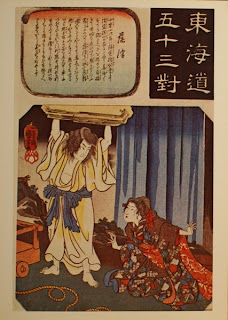Newspapers in Japan
Good evening, everyone. Today, I
would like to tell you about my exciting experience in the university. It was a
project "Mass media in the Oriental countries".As you know, I'm studying the Japanese language, so I had some information about
this subject, but it was really interesting to find out something new!!! So, set comfy
and have a pleasant reading!
Today I would like to give you a general overview of newspapers in Japan.
I’ve divided my presentation into 3 parts. First is going to be the first ways
of getting news, second will be the first Japanese newspapers and finally, the
last point is the up-to-date newspapers in Japan.
I would like to begin with the first recourses of information
in Japan. Nowadays it’s difficult to believe that until the 19th
century there was no print media in Japan. For many centuries the important news was
told by heralds, when they
went to a crowded place and shouted out to the crowd some information which was
written on large wooden boards. These boards were very heavy, that’s why the
heralds use the trolley to bring them all the time.
Now, what about the
first newspapers? The first newspapers appeared in the 17th century. Such
sheets called "kavaraban" were published in Osaka a xylographic way,
using baked clay tablets as a template. These prints "kavaraban» were a
very distant ancestor of the newspapers. This practice continued over two
hundred years, until the Europeans and Americans went to the islands and the
Japanese were allowed to live in Yokohama. So these “gaijins” began to print
their own newspapers, which mostly contained material from various popular
publications and local news.
Now, turning to the
weekly newspapers. In 1861 The Englishman Hensard in Nagasaki, published «Nagasaki Shipping List
and Advertizer» twice a week. In 1864
a German named
Joseph Heno, began to print the newspaper "Kagan Shimbun. Shogun
Takugava liked this idea, that’s why he ordered to publish own newspaper, "Campan Batabia Shimbun."
"Campan Batabia Shimbun" was filled with the information from another
European newspaper.
Let me move on to
the first magazines. The turning point for the Japanese press was 1868, when
"Meiji Revolution" took place in Japan. Then it was decided to
modernize the life of the empire, and one of the main examples of a new life
was the appearance of Japanese
newspapers. They appeared everywhere - in Edo, as Tokyo
was still called, in Kyoto, Osaka
and Nagasaki.
In 1868, the first truly Japanese newspaper "Tyugay Shimbun” was
published." In 1867 Mr Yanagawa Syunsan was trying to produce "Seyu
dzassi" - "West Magazine," which is based on "dzassi",
which is translated from Japanese as
"a variety of writings. "Unfortunately, this newspaper had some
provocation materials and after awhile it stopped to exist because of the
pressure of government bodies.
In 1871, 35 newspapers
were published in Japan
and
My next point is
advertisement. The Japanese newspapers were different from
"non-Japanese": their size was smaller; they looked
"bright" against the background of white newsprint, amazing quality
for the Europeans. Unusual "gaydzinskogo sight" was a Japanese
newspaper for ads. For example, the announcement of the transport firms in the
advertising section of a Japanese newspaper, published in Tokyo was:
"Visit our warehouse! You'll be greeted so warmly, with a sincere
pleasure, as if you are a ray of sun shone in the sky, after several days of
rain and storms. "
Next we come to up-to-dates. Nowadays
the most popular newspaper in Japan is “Yomiuri Shimbun’. It sells ten million
copies a day. This Japanese newspaper is published in Tokyo, Osaka, Fukuoka,
and other major Japanese cities. It is one of the five national newspapers in
Japan; the other four are the Asahi Shimbun, the Mainichi Shimbun, Nihon Keizai
Shimbun, and the Sankei Shimbun. The headquarters is located in Otemachi,
Chiyoda, Tokyo. The paper is printed twice a day and in several different local
editions. The Yomiuri Shimbun is a conservative newspaper.
Yomiuri also publishes The Daily Yomiuri, Japan's
largest English-language
newspaper. It publishes the daily Hochi Shimbun, a sport-specific daily newspaper, as well as weekly and monthly
magazines and books. Yomiuri Shimbun Holdings owns the Chuokoron-Shinsha publishing company, which it acquired in 1999, and the Nippon Television network. It is a member of
the Asia News Network.
Yomiuri Shimbun has been a sponsor of the FIFA
Club World Cup every time it has been held in Japan since 2006.
Yomiuri Shimbun established the Yomiuri Prize in 1948. Its winners include Yukio Mishima and Haruki Murakami, the famous Japanese writers.
So, that brings me to the end of my
presentation.
Let me summarize what we’ve looked at. The
appearance of the newspapers in Japan was not as easy as in other European
countries. But it was rather interesting. Nowadays the Japanese have a very
powerful and rich newspaper industry. And I believe that this nation values
this rich source of information.
In conclusion, I’d like to leave you
with the following idea that the newspapers are a really important source of
information in our life. Use them to be to
know a good thing when one sees it.
Well, thank you for your reading. If you have any questions, I’d be
happy to answer them!











Комментариев нет:
Отправить комментарий